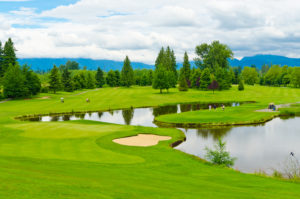
31 Jul Maintaining Golf Course Water Features with Less Chemicals

I talk a lot about soil and grass, but water needs some attention too – the company is called Soil & WATER Consulting! A well-placed water feature can aid with irrigation and the general beauty of the course. Today I thought we’d touch on some tips to identifying issues in golf course water features, like ponds and lakes, and how to potentially address them.
Historically, chemical treatments have been used for controlling problematic algae and aquatic weed growth. Left untreated, these growths can really impact water quality and lead to erosion and odors – no one likes a pungent waft of stagnant pond while they’re out hitting the back nine. Today, we’re seeing a shift away from herbicides and algeacides and a move towards more proactive treatments with less negative environmental impacts.
Preventing Algae
Consider planting aquatic plants in your pond to absorb algae forming nutrients. Algae grows from the nutrients in the water. Adding some more appealing plants, such as lily pads, cattails, or watercress, that will suck up all of those nutrients before the algae can, thus causing them to die off. You should also be mindful of what is getting into the water, like grass clippings and leaves, as these become algae feeding sentiment at the bottom. To prevent this, let’s move to the next tip.
Preventing Erosion
The edges of water features can erode over time, and on a golf course where our measurements are precise and our clients demand predictability and safety in their play, this is unacceptable. Prevent erosion by planting a vegetative border wall. This helps hold the soil in place. Make sure you use several different types of plants to help keep the soil in place, such as Manna grass and cattails. Use vegetation native to your area and avoid plants that are prohibited or illegal in your area.
Preventing Invasive Species
There can only be one plant in a given place and the invasive ones tend to be quite pushy when claiming their territory, such as milfoil, hydrilla, floating crested heart, water hyacinth, and swampweed. You may need to turn to an aquatic herbicide if you spot these bad guys. There are targeted options though that will limit the effects to the species in question.
Soil & Water Consulting can help you enhance your water features
If you’re unsure on what steps you need to take, it’s time to call in a professional. My history as a turfgrass consultant, combined with the water analysis resources available to us via Brookside labs, gives us the power to identify your water feature issues and develop a plan to address and overcome them.

